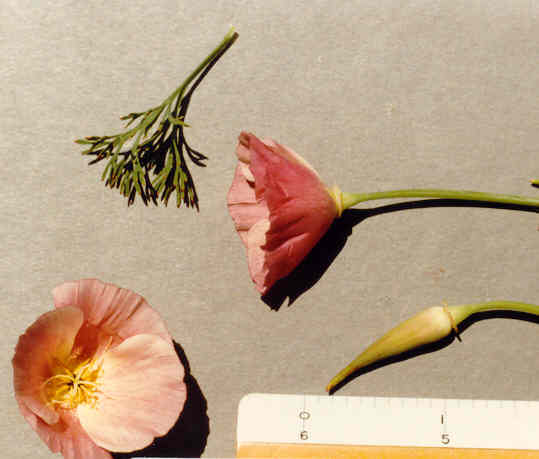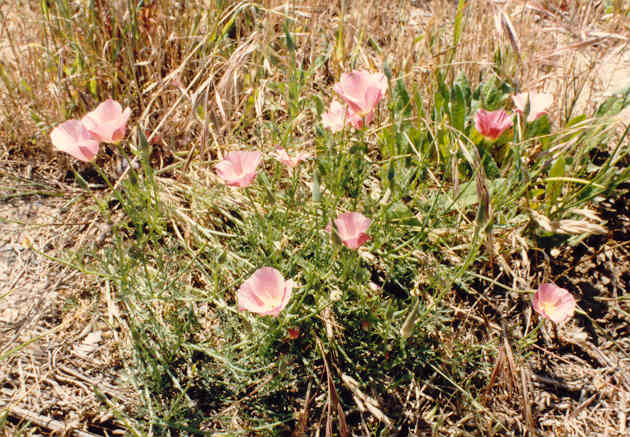
Eschscholzia californica Cham. cv. rosea
 |
Eschscholzia californica Cham. cv. rosea
Papaveraceae (Poppy Family)NativePink California Poppy |
May Photo
Plant Characteristics:
Annual to perennial, flowering the first year, freely branched, +/- glaucous,
generally nearly glabrous, the stems becoming 2-6 dm. long and falling over in
age; lvs. ternately several times dissected into narrow segms., the blades 2-6
cm. long, the basal lvs. petioled; peduncles 3-15 cm. long; torus with 2 rims,
the inner erect and hyaline, the outer spreading and 2-4 mm. wide; calyptra 1-4
cm. long, variable in shape; flowers single, pinkish to light purple, 2-6 cm.
long; caps. 3-8 (-10) cm. long; seeds gray-brown, round-oblong, 1.2-1.5 mm.
long, reticulate with ca. 8-10 meshes per row.
Habitat:
Escape from cultivation.
Name:
Named for Dr. J.F. Eschscholtz,
1793-1831, surgeon and naturalist with Russian expeditions to Pacific Coast in
1816 and 1824. (Munz, Flora So. Calif. 626).
General:
Rare in the study area having only been found once, and this along Back
Bay Dr. nearly at the point where it intersects Eastbluff Dr.
(my comment).
Fred Roberts says that a cultivator, cv., is less of a change in a
species that a var. or ssp. and that it is a change induced by man. There is a long list of the cultivars of E. californica in Huxley’s New
Royal Horticultural Dictionary of Gardening, Vol. II 211.
Some flower-frequenting insects, such as blister beetles (Meloidae),
and checkered beetles (Cleridae), use
flowers as a linkage in a complex life history. Their females may give birth to a tiny louse-like larvae in
flower. These crawl in the
"fur" of bees and are carried in the bees' nest chambers where they
complete their development by eating pollen provisions intended for the bees
larvae. Blister beetles will eat
California poppy flowers, a plant that few insects can tolerate as a food
source. (Ross, Edward S.,
"Insect/Plant Relationships: A Photographic Essay".
FREMONTIA, A Journal of the California Native Plant Society, April
1996 pp.2-22). About a dozen spp., from
Columbia R. to n. Mex. (Munz, Flora
So. Calif. 626).
Text Ref:
Bailey & Bailey 448; Munz, Flora
So. Calif. 627.
Photo Ref:
May 1 87 # 20,21.
Identity: by F. Roberts.
First Found: May 1987.
Computer Ref: Plant Data 319.
Plant specimen donated to UC Riverside in 2004.
Last edit 8/7/05.
 |
May Photo